A CNT-Toughened Strategy for In-Situ Repair of Aircraft Composite Structures
Abstract
1. Introduction
2. Materials, Specimen Manufacturing, and Experimental Procedures
2.1. Materials
2.2. Specimen Manufacturing
2.3. Set-up and Equipment
2.4. Double Cantilever Beam (DCB) Set-Up and Tests
3. Experimental and Simulation Results and Analysis
3.1. Experimental Behavior, Crack Length a and Energy Release Rate GIC
3.2. Simulation Method and Results
3.2.1. Cohesive Damage Theory
3.2.2. FEM Model
3.3. Analysis of Fracture Appearance
3.3.1. Macro-Scale Analysis
3.3.2. Micro-Scale Analysis
3.4. Summary of the Toughening Mechanism of MWCNTs
4. Conclusions
- This paper proposed a convenient, low-cost, and efficient field-repair approach for enhancing the interlaminar fracture toughness of CFRPs. For Mode I fracture toughness, MWCNTs can greatly enhance interlamilar toughness, compared with PWCs. The average value of GIC increased by 102.92%. Despite removing the maximum GIC value in the MWCNTs group, it continued to show 95% improvement. The density of the MWCNTs was 1.58 g/m2.
- The load-displacement curves of the original and MWCNTs-toughening groups behaved in three stages: linear increasing, nonlinear increasing, and nonlinear decreasing. Compared with the original group, not only did the maximum load peak of MWCNTs toughening group increase by 19.5%, but the slope rate of nonlinear decreasing phase also decreased, by 63.8%. Both changes indicated that adding MWCNTs at each interface between the prepreg layers improves toughness.
- In comparing the simulation with the experiment, the good agreement of load-displacement and GIC value confirmed that the FEM model and the mechanical parameters were validated. The built-in cohesive element with a bilinear traction-separation relationship was utilized to capture delamination, and the mix-mode criterion of B-K described the damage evolution of the cohesive element, which was suitable for the original epoxy resin and MWCNTs interlaminar simulation.
- The fracture appearances of original group were smooth and without obvious fiber bridging, but the surfaces of the MWCNTs group were rough. A large amount of F-M interface debonding and matrix cracking in mountain shape were the major modes of fracture, with little fiber breakage and matrix peeling. The reason for the rough surface is found in the embedded MWCNTs. The initiated cracks of F-M interface debonding deflected in the matrix when meeting MWCNTs, which led to the fracture appearance in mountain shape. Such a fracture appearance in mountain shape caused the crack length to increase and led to GIC improvement.
Author Contributions
Funding
Conflicts of Interest
References
- Liu, B.; Han, Q.; Zhong, X.; Lu, Z. The impact damage and residual load capacity of composite stepped bonding repairs and joints. Compos. Part B Eng. 2018, 158, 339–351. [Google Scholar] [CrossRef]
- Pai, Y.; Pai, K.D.; Kini, M.V. A review on low velocity impact study of hybrid polymer composites. Mater. Today Proc. 2021, 46, 9073–9078. [Google Scholar] [CrossRef]
- Mcilhagger, A.T.; Quinn, J.P.; McIlhagger, R. The Tailoring of Composite Mechanical Properties by Textile Reinforcement Design. In Proceedings of the SheMet University of Ulster, Jordanstown, UK, 14–16 April 2003. [Google Scholar]
- Fishpool, D.T.; Rezai, A.; Baker, D.; Ogin, S.L.; Smith, P.A. Interlaminar toughness characterisation of 3D woven carbon fibre composites. Plast. Rubber Compos. 2013, 42, 108–114. [Google Scholar] [CrossRef]
- Dransfield, K.; Baillie, C.; Mai, Y.W. Improving the delamination resistance of CFRP by stitcching—A review. Compos. Sci. Technol. 1994, 50, 305–317. [Google Scholar] [CrossRef]
- Mouritz, A.P. Review of z-pinned composite laminates. Compos. Part A Appl. Sci. Manuf. 2007, 38, 2383–2397. [Google Scholar] [CrossRef]
- Kobayashi, S.; Sugimoto, K.-I.; Nakai, A.; Hamada, H. Improvement in damage tolerance of CFRP laminate using the hybridization method. Compos. Interfaces 2005, 12, 629–635. [Google Scholar] [CrossRef]
- Kim, J.K. Methods for improving impact damage resistance of CFRPs. In Key Engineering Materials; Trans Tech Publications Ltd.: Baech, Switzerland, 1998; Volume 141, pp. 149–168. [Google Scholar]
- Shin, Y.C.; Kim, S.M. Enhancement of the interlaminar fracture toughness of a carbon-fiber-reinforced polymer using interleaved carbon nanotube buckypaper. Appl. Sci. 2021, 11, 6821. [Google Scholar] [CrossRef]
- Iijima, S. Helical microtubules of graphitic carbon. Nature 1991, 354, 56–58. [Google Scholar] [CrossRef]
- Hamer, S.; Leibovich, H.; Green, A.; Avrahami, R.; Zussman, E.; Siegmann, A.; Sherman, D. Mode I and Mode II fracture energy of MWCNT reinforced nanofibrilmats interleaved carbon/epoxy laminates. Compos. Sci. Technol. 2014, 90, 48–56. [Google Scholar] [CrossRef]
- Joshi, S.C.; Dikshit, V. Enhancing interlaminar fracture characteristics of woven CFRP prepreg composites through CNT dispersion. J. Compos. Mater. 2012, 46, 665–675. [Google Scholar] [CrossRef]
- Tong, L.; Sun, X.; Ping, T. On the of long carbon nanotubes on Mode I delamination toughness of laminated composites. J. Compos. Mater. 2008, 42, 5–23. [Google Scholar] [CrossRef]
- Khan, S.U.; Kim, J.K. Interlaminar Shear Properties of CFRP Composites with CNF-Bucky Paper Interleaves. In Proceedings of the 18th International Conference on Composite Materials, Copenhagen, Denmark, 15–18 August 2011. [Google Scholar]
- Almuhammadi, K.; Alfano, M.; Yang, Y.; Lubineau, G. Analysis of interlaminar fracture toughness and damage mechanisms in composite laminates reinforced with sprayed multi-walled carbon nanotubes. Mater. Des. 2014, 53, 921–927. [Google Scholar] [CrossRef]
- Liu, B.; Cao, S.; Gao, N.; Cheng, L.; Liu, Y.; Zhang, Y.; Feng, D. Thermosetting CFRP interlaminar toughening with multi-layers graphene and MWCNTs under mode I fracture. Compos. Sci. Technol. 2019, 183, 107829. [Google Scholar] [CrossRef]
- Karuppannan, D.; Rawat, R.S.; Ramachandra, H.V.; Saji, D.; Byji, V. Composites for reinforcement of damaged metallic aircraft wings. J. Aerosp. Sci. Technol. 2013, 65, 8–13. [Google Scholar]
- Monsalve, A.; Solís, R.; Díaz, M.; Carrasco, S.; Artigas, A. Multi-walled carbon nanotube reinforced polymer as a bonded repair for Al 2024-T3 fatigue crack growth. Matéria 2018, 23. [Google Scholar] [CrossRef]
- Changduk, K.; Hyunbum, P.; Sungjin, L. Study on Strength Recovery of Impact Damaged Composite Laminate by External Patch Repair. In Proceedings of the 2010 Asia-Pacific International Symposium on Aerospace Technology, Xi’an, China, 13–15 September 2010; pp. 852–855. [Google Scholar]
- Liu, B.; Gao, N.; Cao, S.; Ye, F.; Liu, Y.; Zhang, Y.; Cheng, L.; Kikuchi, M. Interlaminar toughening of unidirectional CFRP with multilayers graphene and MWCNTs for ModeⅡfracture. Compos. Struct. 2020, 236, 111888. [Google Scholar] [CrossRef]
- ASTM. D5528-01, in Standard Test Method for Mode I Interlaminar Fracture Toughness of Unidirectional Fiber-Reinforced Polymer Matrix Composites; ASTM International: West Conshohocken, PA, USA, 2019. [Google Scholar]
- Sorensen, L.; Botsis, J.; Gmür, T.; Humbert, L. Bridging tractions in mode I delamination: Measurements and simulations. Compos. Sci. Technol. 2008, 68, 2350–2358. [Google Scholar] [CrossRef]
- Benzeggagh, M.L.; Kenane, M. Measurement of Mixed-Mode Delamination Fracture Toughness of Unidirectional Glass/Epoxy Composites with Mixed-Mode Bending Apparatus. Compos. Sci. Technol. 1996, 56, 439–449. [Google Scholar] [CrossRef]

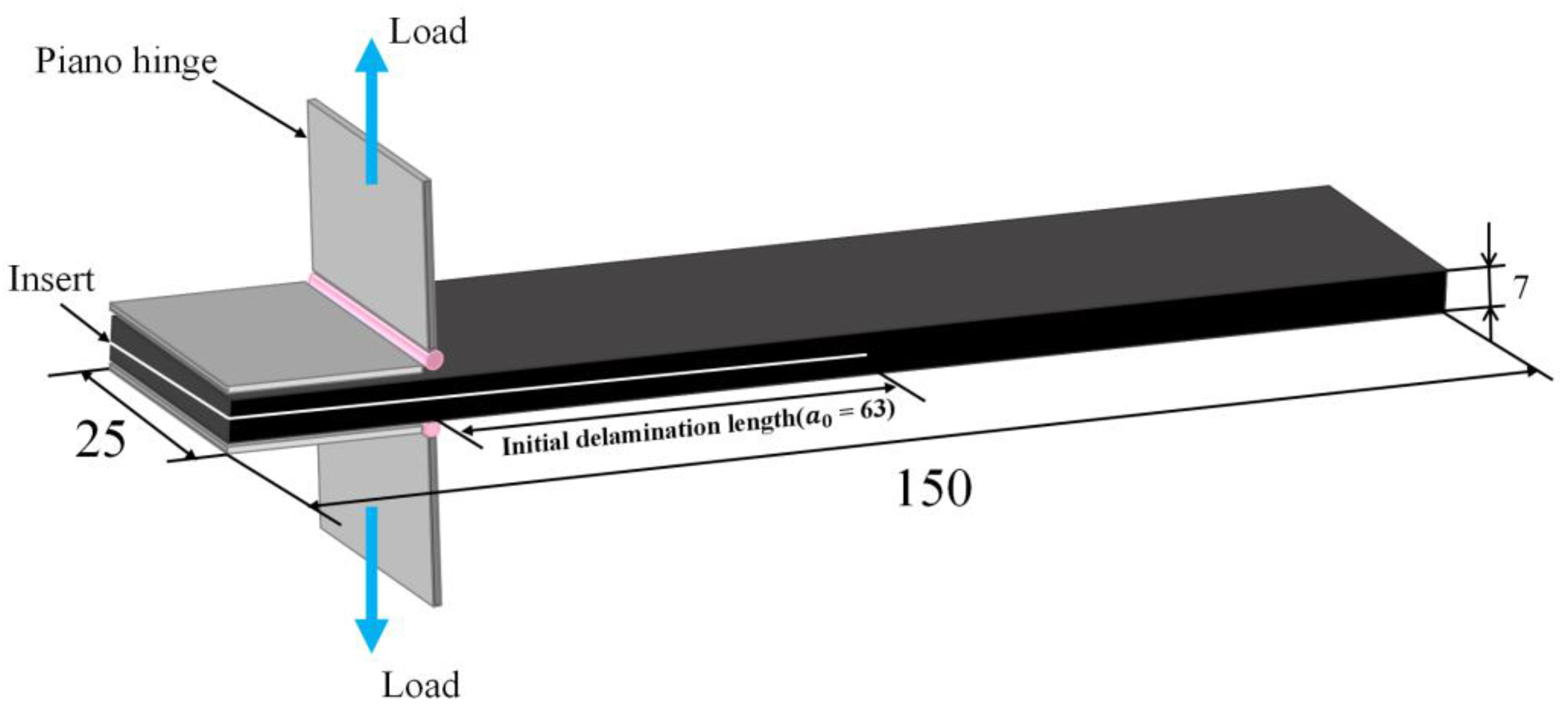



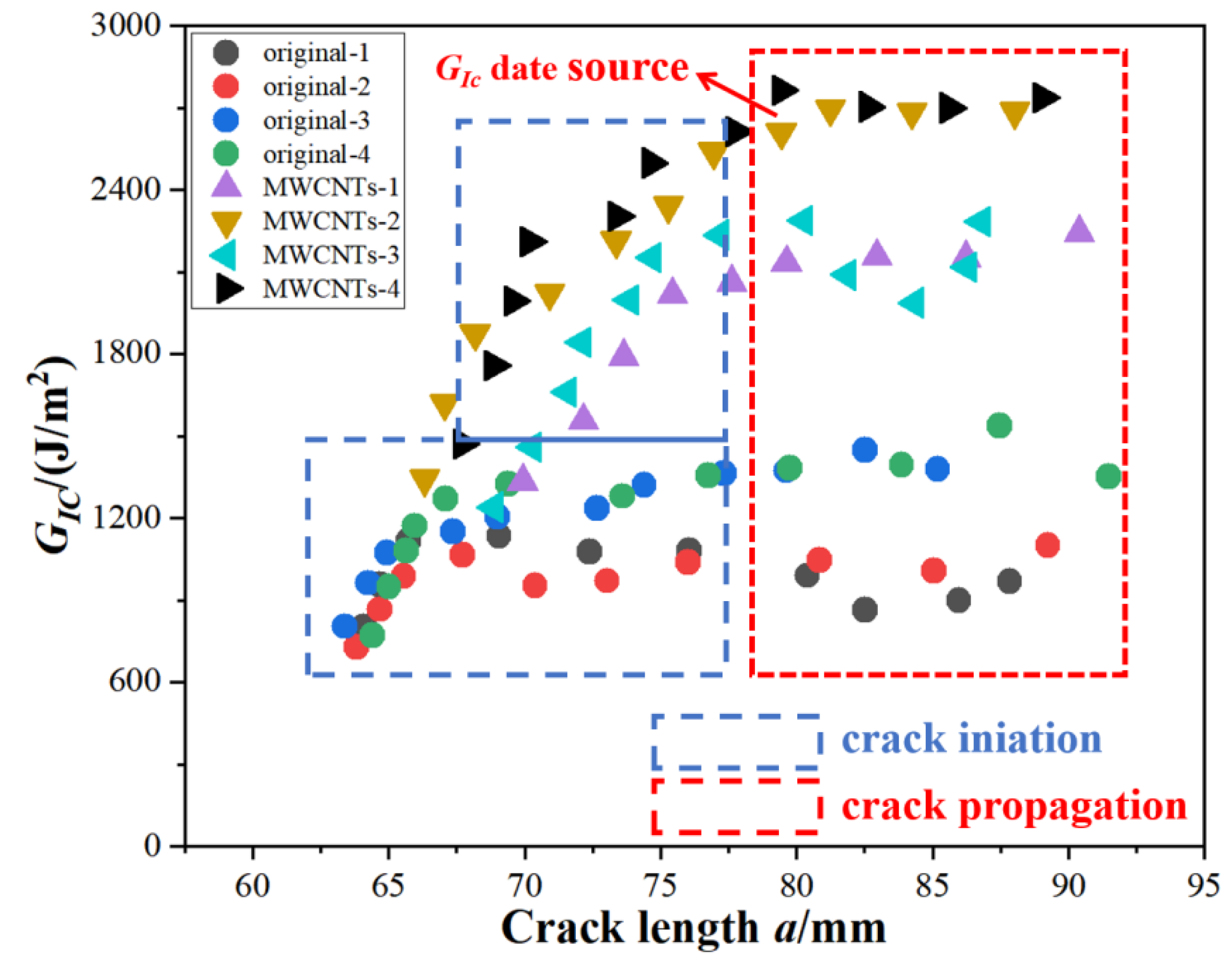
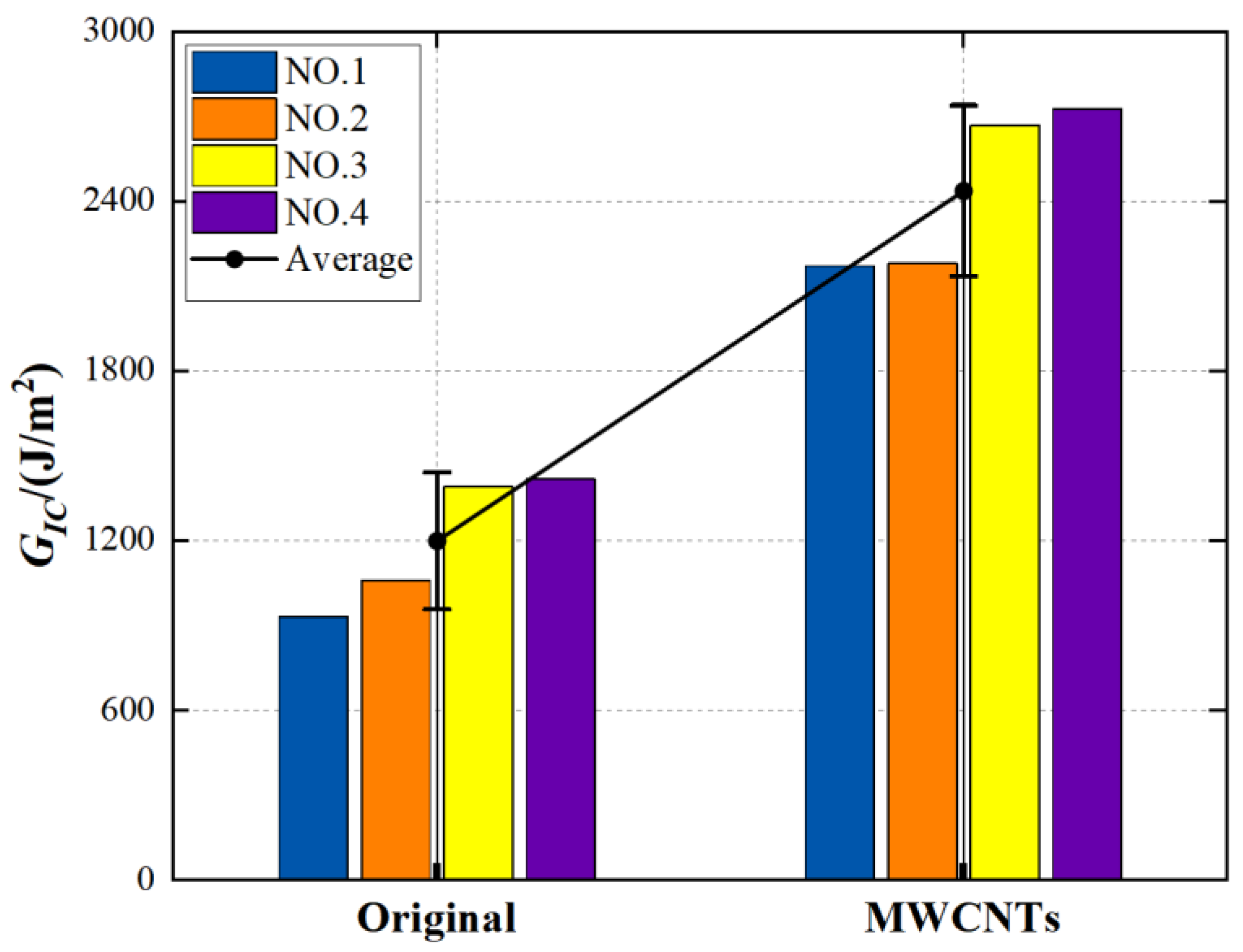
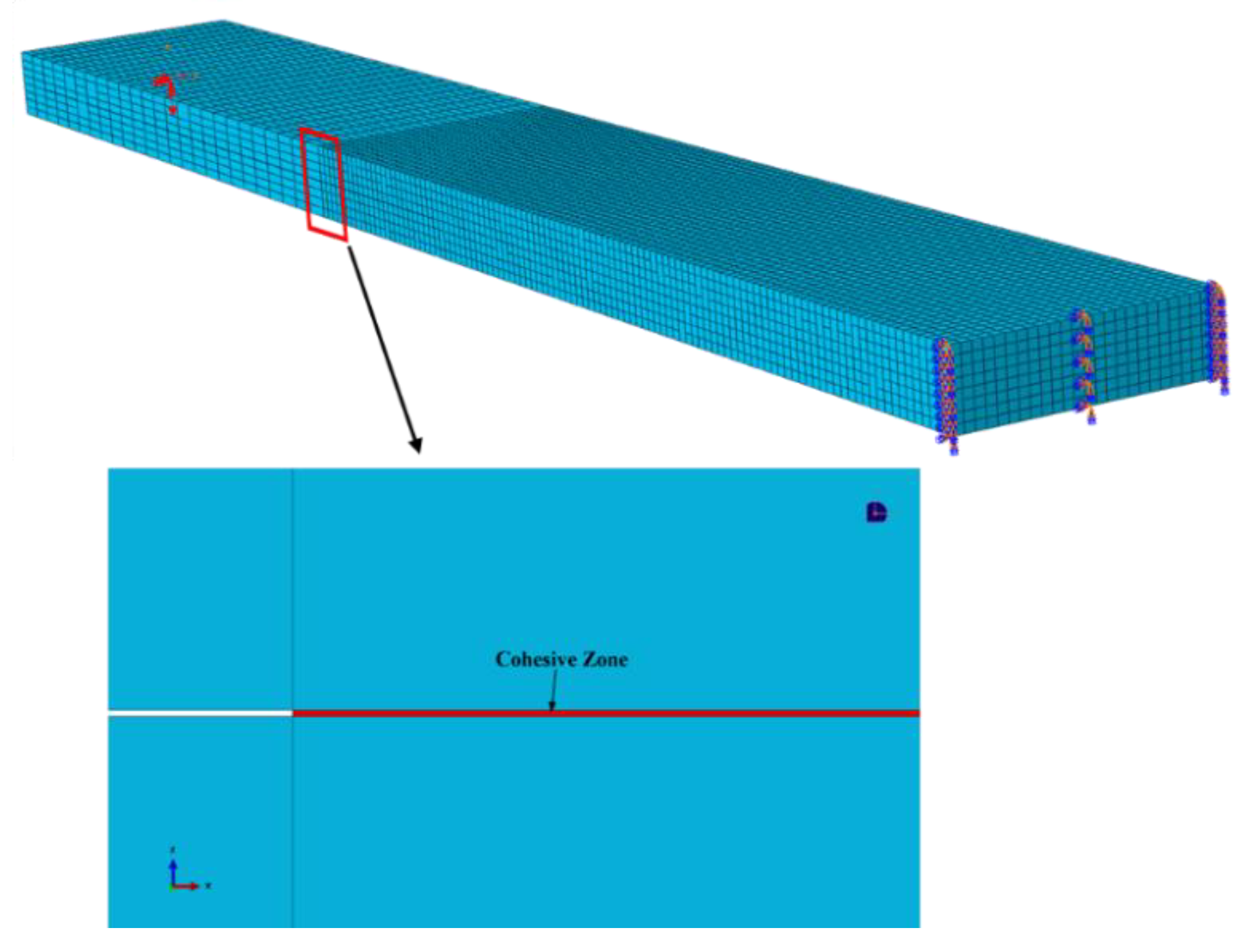

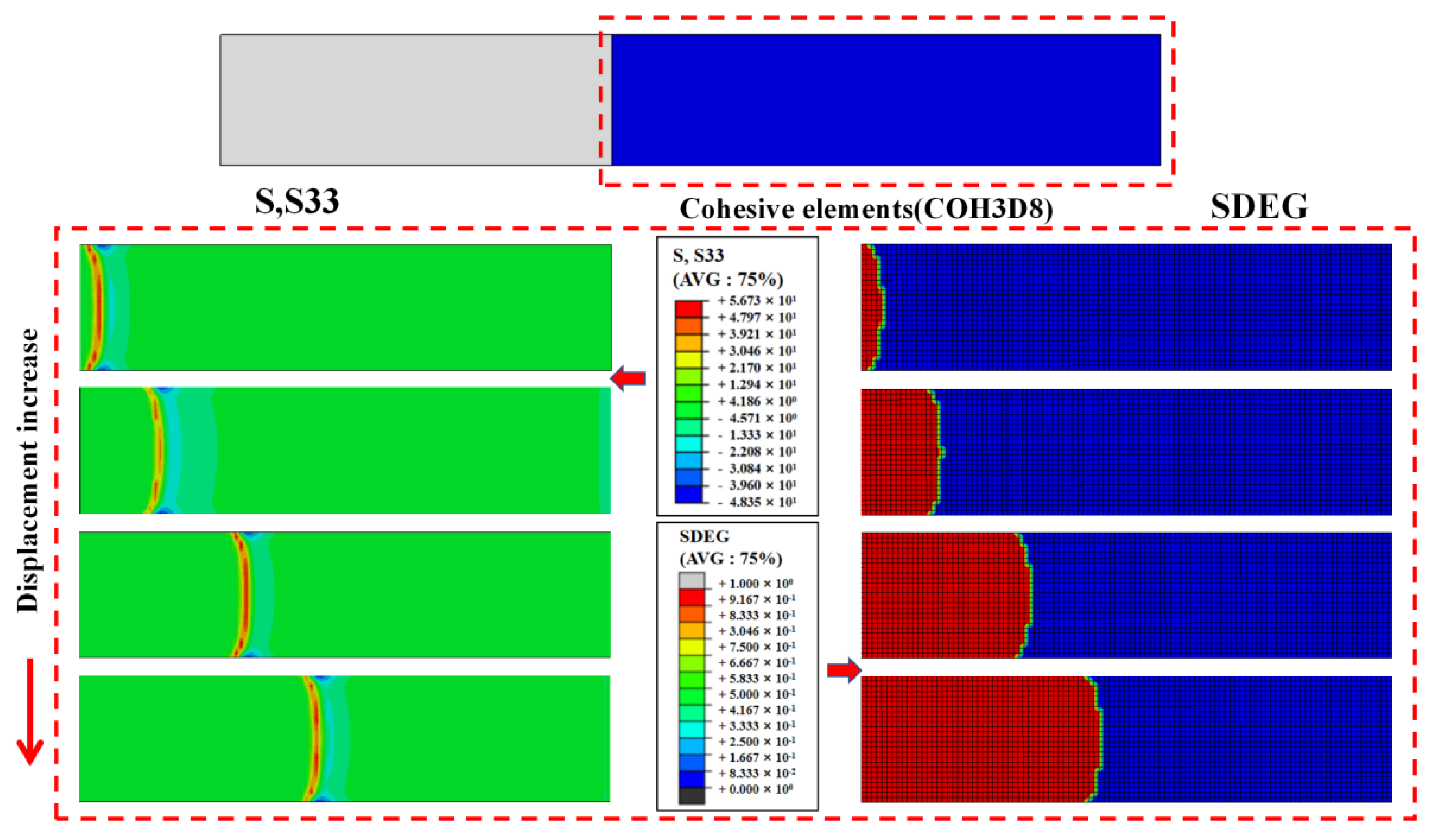
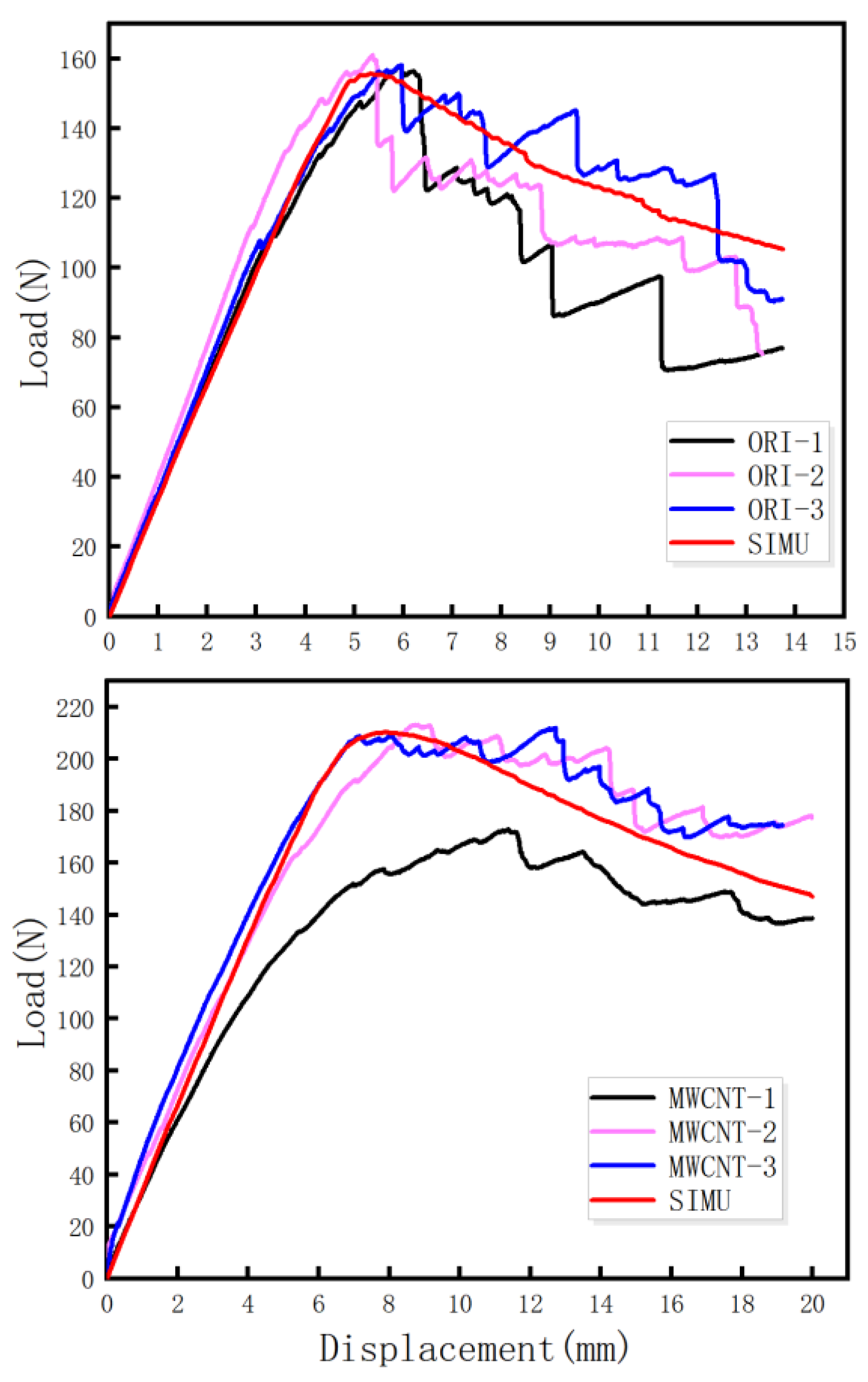
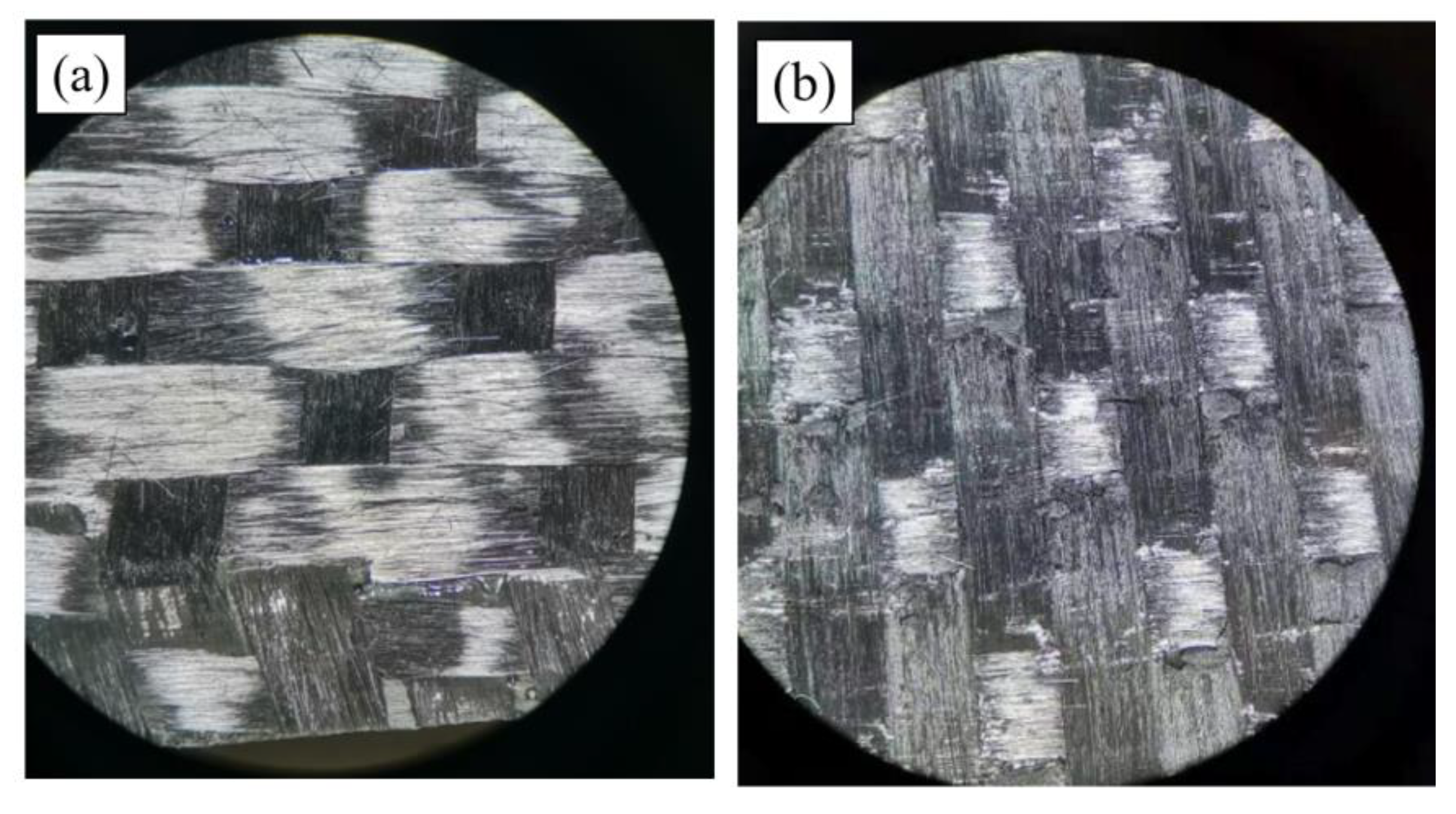
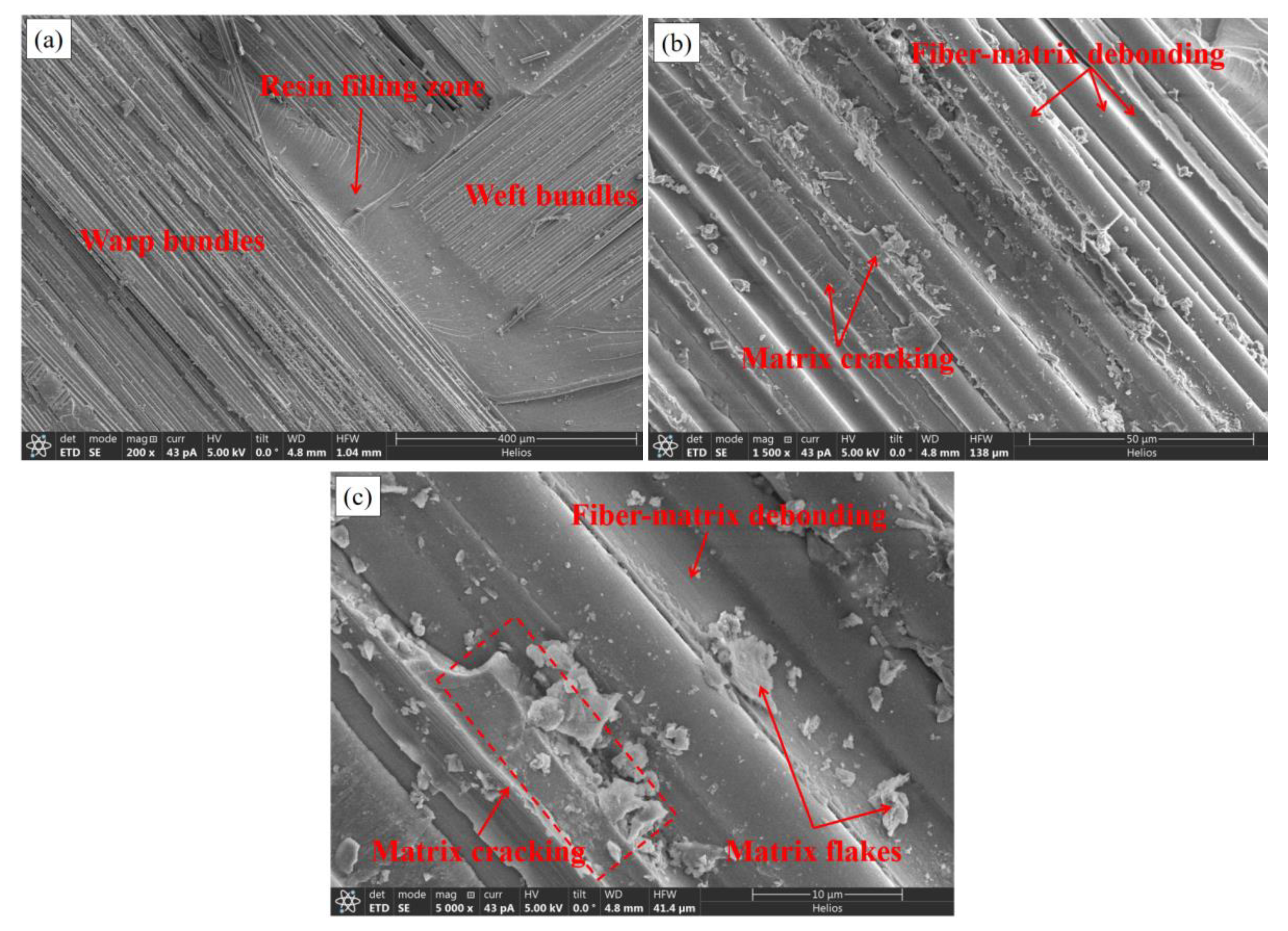
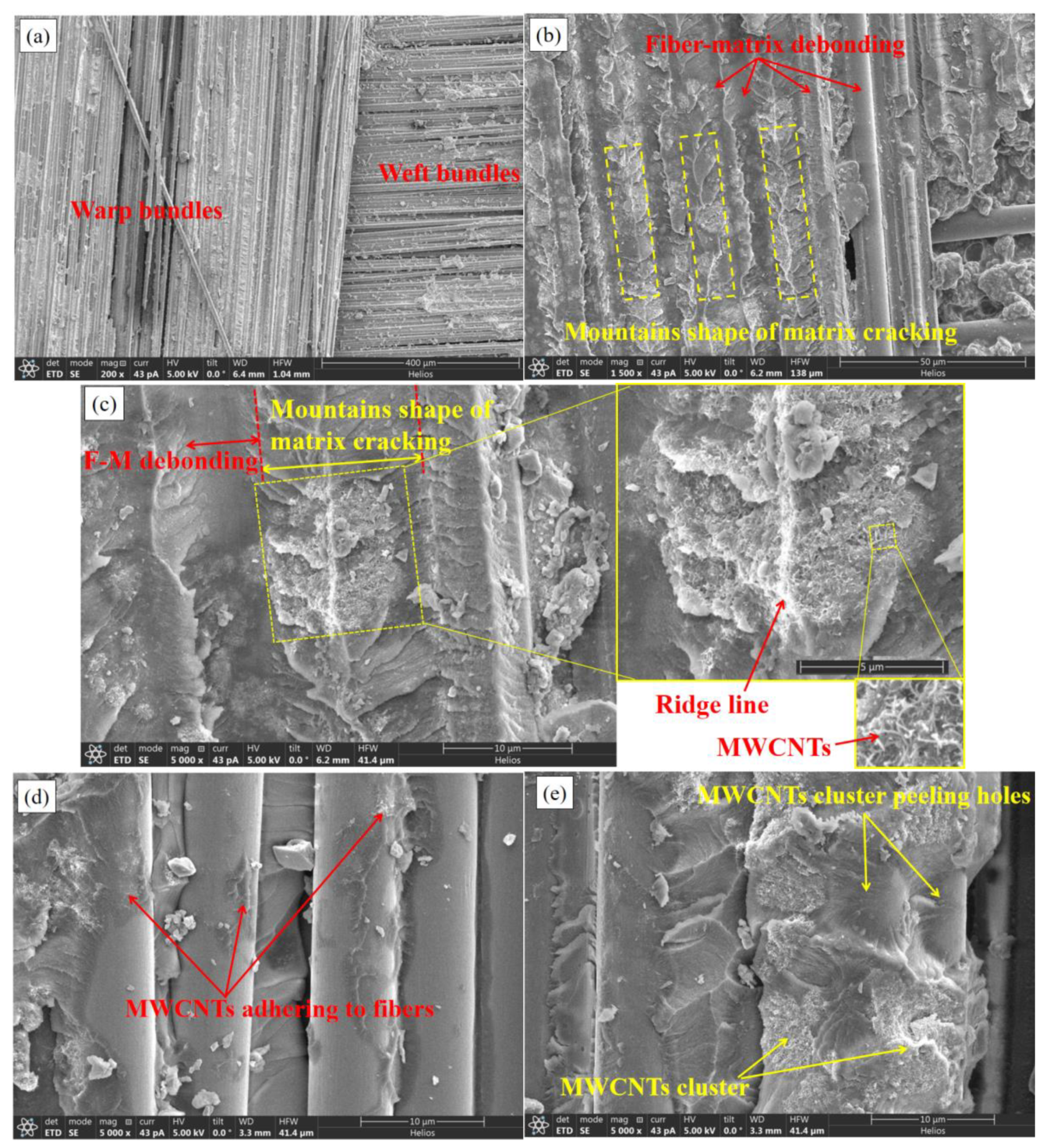
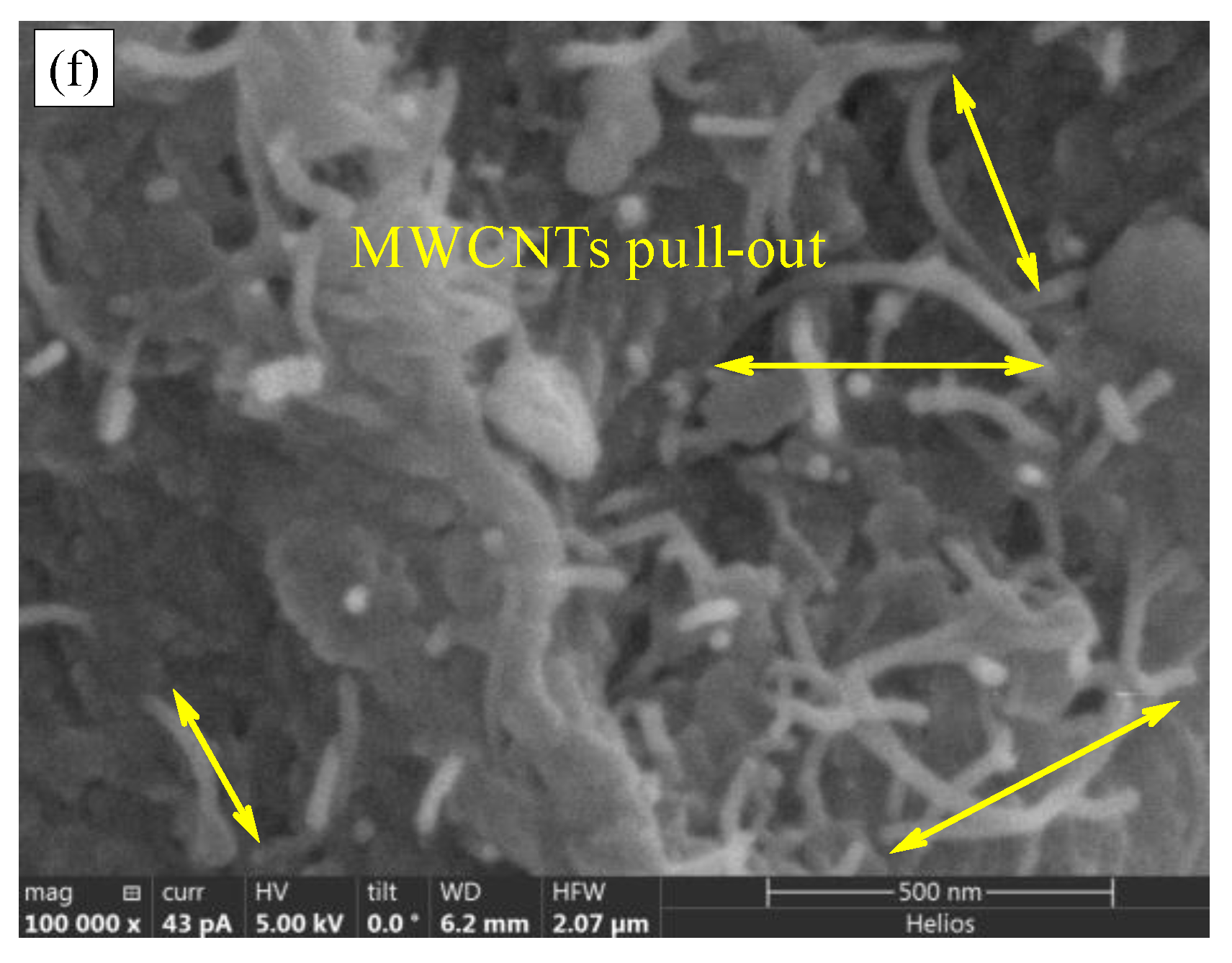
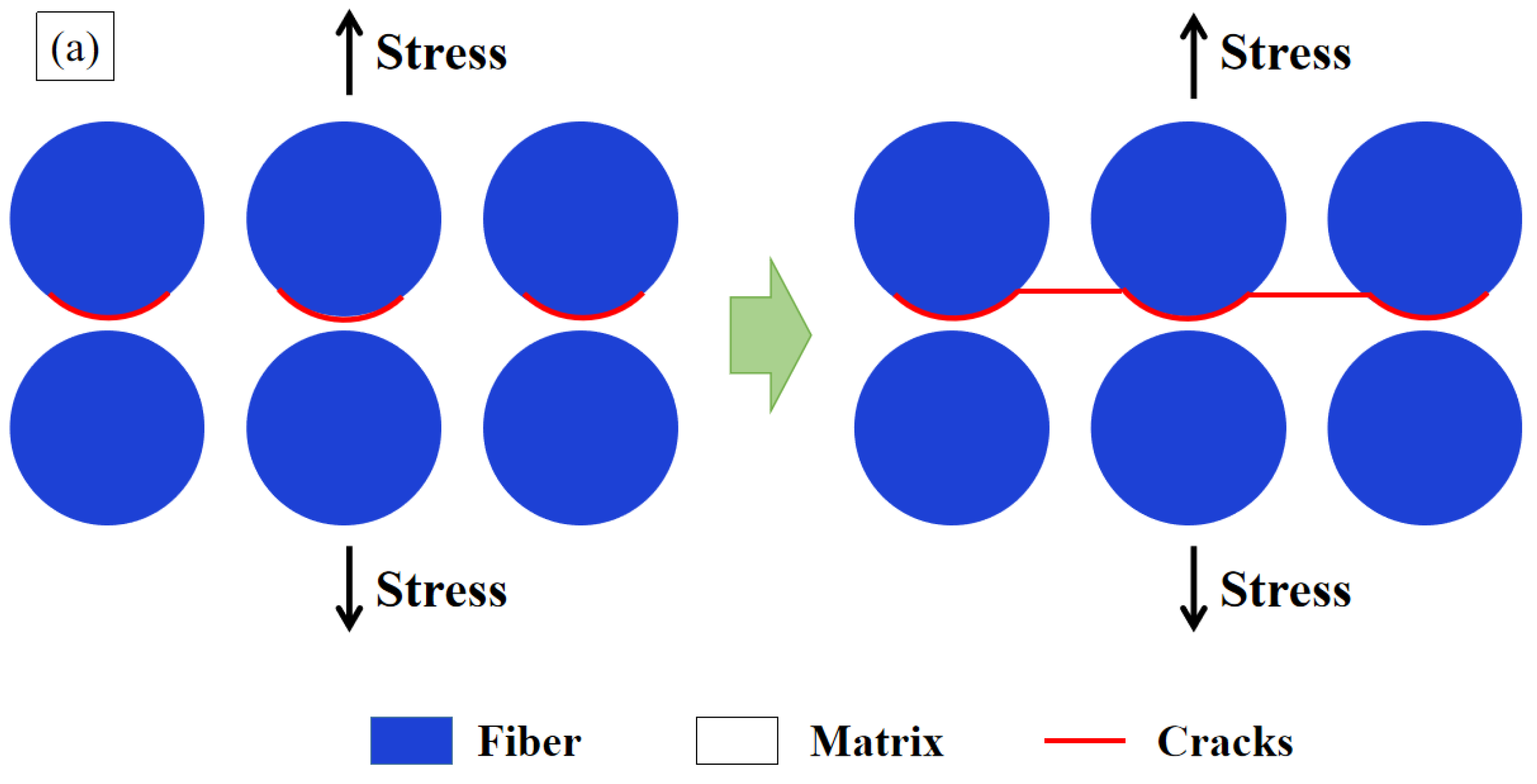
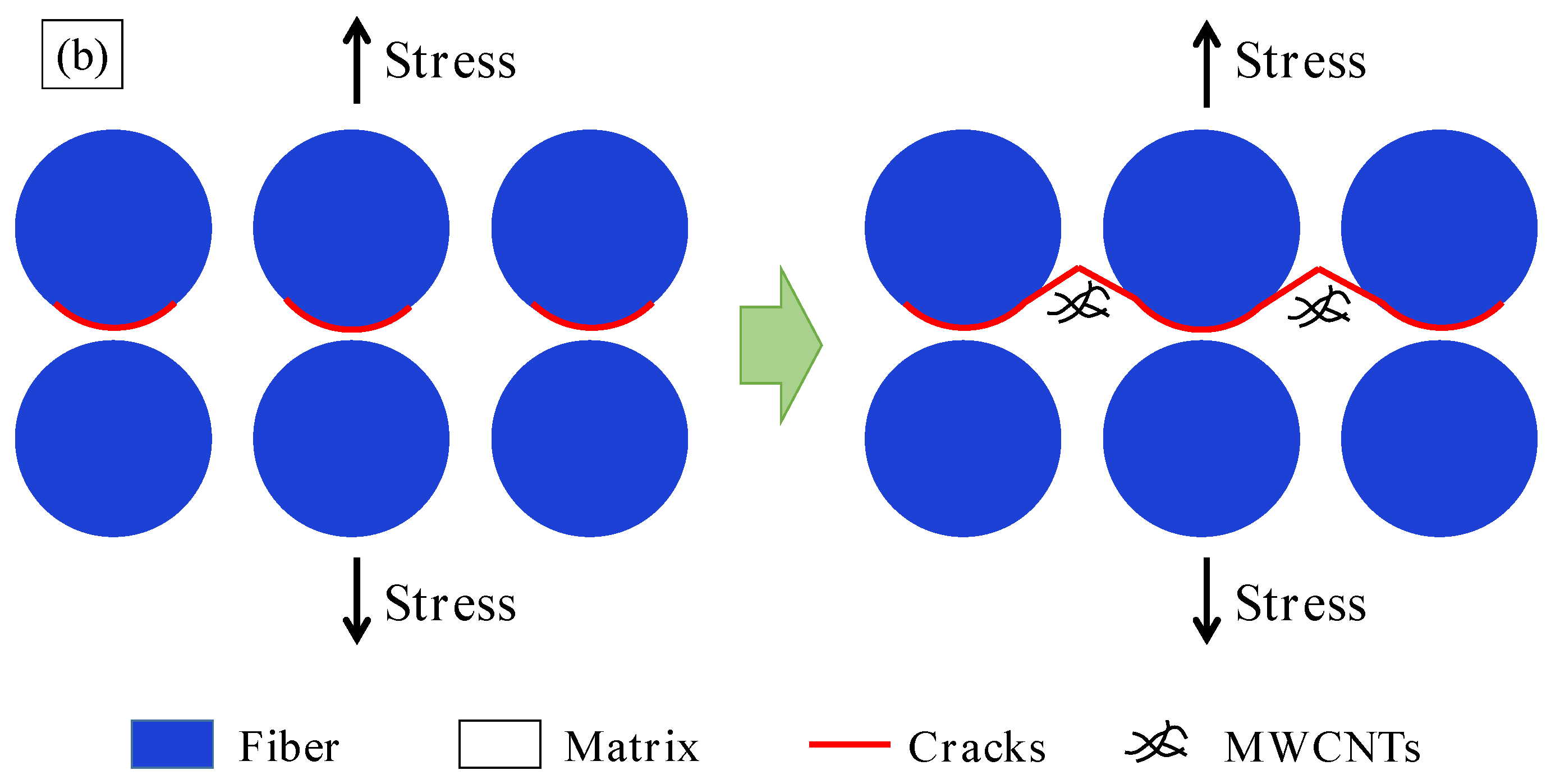
| Materials | Type | Elongation to Break (%) | Tensile Modulus (GPa) | Tensile Strength (MPa) | Density (g/cm3) |
|---|---|---|---|---|---|
| Carbon fiber | T700-3K | 2.0 | 240 | 4900 | 1.80 |
| Epoxy resin | EA 9390 AERO | 2.5 | 2.88 | 56.5 | 1.15 |
| Specimens | Pmax/N | Average Value | Increasing Rate/% | Slope/% | Average Value | Decreasing Rate/% |
|---|---|---|---|---|---|---|
| Original | 163.2 | 168.3 | - | 10.9 | 10.5 | - |
| 166.9 | 10.9 | |||||
| 164.0 | 11.0 | |||||
| 179.2 | 9.1 | |||||
| MWCNTs toughening | 180.5 | 201.2 | 19.5% ↑ | 3.9 | 3.8 | 63.8% ↓ |
| 218.5 | 5.2 | |||||
| 185.7 | 3.0 | |||||
| 219.9 | 3.2 |
| Materials | Parameters | Values |
|---|---|---|
| Composite | Young’s modulus | |
| Shear modulus | ||
| Poisson’s ratio | ||
| Cohesive | Modulus | N/mm2 |
| Strength | ||
| Fracture Energy | (Original) J/m2 | |
| (MWCNT) |
Publisher’s Note: MDPI stays neutral with regard to jurisdictional claims in published maps and institutional affiliations. |
© 2022 by the authors. Licensee MDPI, Basel, Switzerland. This article is an open access article distributed under the terms and conditions of the Creative Commons Attribution (CC BY) license (https://creativecommons.org/licenses/by/4.0/).
Share and Cite
Yang, T.; Chu, S.; Liu, B.; Xu, F.; Wang, B.; Wu, C. A CNT-Toughened Strategy for In-Situ Repair of Aircraft Composite Structures. Materials 2022, 15, 7691. https://doi.org/10.3390/ma15217691
Yang T, Chu S, Liu B, Xu F, Wang B, Wu C. A CNT-Toughened Strategy for In-Situ Repair of Aircraft Composite Structures. Materials. 2022; 15(21):7691. https://doi.org/10.3390/ma15217691
Chicago/Turabian StyleYang, Tengfei, Shiyong Chu, Bin Liu, Fei Xu, Bo Wang, and Chengwei Wu. 2022. "A CNT-Toughened Strategy for In-Situ Repair of Aircraft Composite Structures" Materials 15, no. 21: 7691. https://doi.org/10.3390/ma15217691
APA StyleYang, T., Chu, S., Liu, B., Xu, F., Wang, B., & Wu, C. (2022). A CNT-Toughened Strategy for In-Situ Repair of Aircraft Composite Structures. Materials, 15(21), 7691. https://doi.org/10.3390/ma15217691






